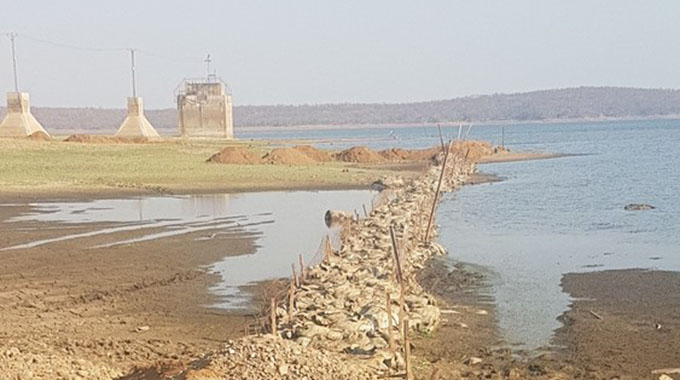
Isdore Guvamombe Assistant Editor
Kariba Dam, which for 60 years towered over one of Africa’s mightiest rivers — the Zambezi — impounding one of the world’s largest reservoirs and providing reliable electricity to Zambia and Zimbabwe, has shrivelled to a ghost of its former self.
And, unfortunately, the future does not look like the past will ever return, as intermittent droughts and erratic rainfall patterns ebb its inflows.
The lake level is now at an unprecedented below 30 percent of maximum, forcing Zambezi River Authority (ZRA) to ration increasingly tightly.
Where in the past dam water flourished in wash and swash superfluous benevolence, the shoreline has receded, in some instances by more than 1km leaving behind a vast swathe of land baked into dry cracked cakes of soil, as day-after-day of cloudless skies, allow the sun to suck moisture.
Again, where water used to wash over shallow shores, enterprising boys have found grounds for football and volleyball pitches and drive-in picnic sites.
Traditional fishermen, who used to leave their wives home already preparing the bisque for the next fish meal sure they would bring enough catch for dinner, are now returning empty-handed.
It is only game on for anglers who use engine-powered boats. But even for them, the space is getting smaller.
The multi-million-dollar kapenta fishing industry is worried that breeding zones, the shallows where land and water meet in azure coves, are fast receding and fertilised eggs being exposed at the expense of reproduction of the small fish, the mainstay of Kariba.
The availability of zoo plankton, the main food for kapenta, is now under threat as the lake depletes.
Where water used to be abundant, new islands peak scarily, as the water levels shilly shally. The tourism and
hospitality industry has not been spared either; boating companies are having to fork out thousands of dollars to construct new harbours for docking. Many new launch pads and harbours are now required as the water recedes fast, leaving the boats offshore.
Companies like Padenga who are into massive crocodile farming have been forced to extend their water pipe lines into deeper waters as the dam retreats daily leaving behind traditional pump houses panting on the open.
After intermittent droughts that gripped the region, flow on the Zambezi River has dwindled to a quarter of what it was, same time last year.
By decommissioning the dam, electricity supply will be stopped and residents of Kariba, have for the first time experienced unprecedented power cuts.
“The Kariba Dam has been absolutely essential for the region,” said Randall Spalding-Fecher, an energy adviser whose doctoral thesis included examining how climate change may impact hydropower on the Zambezi.
“The challenge is the future doesn’t look like the past.”
Lake Kariba is fed from rainfall in a catchment area of 1 352 000 square km, more than half the size of South Africa and larger than France.
The Zambezi River rises in north western Zambia and its catchment area covers eight countries, namely Angola, Botswana, Malawi, Mozambique, Namibia, Tanzania, Zambia and Zimbabwe. It enters the Indian Ocean in Mozambique at Quelimane.
It flows for some 2 650 kilometres from its source to the Indian Ocean. It is the fourth largest river in Africa after the Congo, the Nile and the Niger and it is the largest river in Africa flowing into the Indian Ocean.
Kariba Dam is located approximately halfway down the Zambezi River, which is divided into four distinct sections, namely; Upper Catchment Level (Northern Highlands); High Level Plateau, north of Lukula, the Zambezi River’s source.
Middle Catchment, (Central Plains), stretching from source to Victoria Falls.
Lower Catchment, (Northwestern drainage area of the Zambezi); Lake Kariba lies within this area in the Gwembe Valley.
The average annual rainfall varies from 1,5 metres in the North to 0,7 m in the South, with the run-off factors varying generally from 0 to 16 percent and reaching 100 percent on the 1,3 sq km surface of the Lake.
The entire catchment area is generally difficult to access and in some cases its watershed boundaries are indeterminate.
But Kariba is not alone as world climate change bites. The world over, climate change is sapping hydropower’s dependability as rivers that once ebbed and flowed with seasonal regularity have grown erratic. In Brazil, record drought triggered blackouts in 2015. In California, output from dams has swung wildly from year to year. And in Europe, Spanish utility giant Iberdrola SA’s hydro output reached a record high in 2016, then plunged 57% the following year.
The shift in climate is sending shivers in countries that depend on dams for power and is prompting utilities and investors to more closely and re-look at what has of been one of the largest sources of carbon-free electricity.
“Hydropower is going to be less effective,” says Jenny Kehl, a professor at the University of Wisconsin-Milwaukee’s School of Freshwater Sciences.
“As the water levels decline, the capacity for hydropower plants to generate electricity will decrease.”
“The industry has had an awakening,” said Mike Haynes, COO of Seattle City Light, which gets 90% of its power from hydroelectric dams.
While Zimbabwe and Zambia are planning another dam upstream on the Zambezi to address electricity shortages, it might be time to pause and think again.
The river, meanwhile, is near its lowest level in half a century.
The dam which usually overspills during the rainy season into winter when the Zambezi is in full flow, may not experience any over spill this year, authorities said.
While expectations are high that the river and dam will record inflows, water levels dropped by three metres between October 2018 and February this year. The levels further dropped to five metres above minimum operating level.
And, while droughts may come and go, the river’s future looks grim. The lethargy of climate change is real and will be with us for long.
